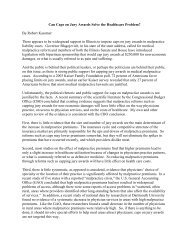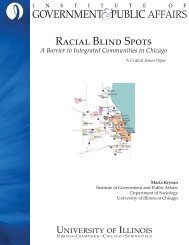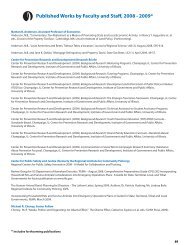Declining Housing Prices and Property Taxes - Institute of ...
Declining Housing Prices and Property Taxes - Institute of ...
Declining Housing Prices and Property Taxes - Institute of ...
- No tags were found...
You also want an ePaper? Increase the reach of your titles
YUMPU automatically turns print PDFs into web optimized ePapers that Google loves.
Figure 5<strong>Property</strong> Tax as a Percentage <strong>of</strong>General Own-Source Revenue, LocalGovernmentsPercent727170696867661997 2002 2007Source: U.S. Census Bureau, Census <strong>of</strong> Governmentsprices. 2 Lutz conducts the analysis usingtwo data sets—aggregate national data for1976-2007 on property tax revenue <strong>and</strong>house prices, <strong>and</strong> a comparable data setcovering all local governments in the U.S.for 1985-2005. Both <strong>of</strong> these periods aretimes when house prices were risingthroughout most <strong>of</strong> the nation. In contrastto the evidence presented in Figures 3-5,he concludes that:“The evidence suggests property tax revenuesare quite responsive to changes inhouse prices. Although it takes several yearsfor house price appreciation to feed throughto property tax revenues, the long-run elasticityis on the order <strong>of</strong> 0.4. On average,policymakers are estimated to respond toincreasing home prices by 60 percent <strong>of</strong> theincrease in tax revenue that would haveoccurred in the absence <strong>of</strong> a change in theeffective tax rate.” (Lutz, 2008, p. 566)In a subsequent paper, Lutz, Molloy, <strong>and</strong>Shan analyze the channels by which thehousing market affects state <strong>and</strong> local taxrevenue. 3 At its most basic level, a jurisdiction’sproperty tax revenue (T) is simplythe product <strong>of</strong> its effective tax rate (t) <strong>and</strong>the market value <strong>of</strong> its taxable property(V): T = tV. The first channel by whichchanges in house prices affect revenue isentirely mechanical: if the tax rate is constant<strong>and</strong> the market value <strong>of</strong> taxable propertychanges from V 1 to V 2 , then revenuerises by t(V 2 -V 1 ). However, tax rates maychange when property values increase. Ifboth V <strong>and</strong> t change, then the full changein revenue is T 2 -T 1 = t(V 2 -V 1 ) + (t 2 -t 1 )V 1 .Other channels by which changes in houseprices affect tax revenue are less direct.<strong>Declining</strong> house prices may reduce construction,which reduces sales tax revenuefrom construction materials <strong>and</strong> perhapsincome taxes from construction workers. Agrowing recent literature suggests that risinghouse prices increase consumptionexpenditures by making consumers feelwealthier. 4 Thus, declines in house pricesmay lead to lower sales tax collections.Similarly, voters will be less inclined tosupport expenditure bills when their propertyvalues fall.The study by Lutz, Molloy, <strong>and</strong> Shan suggeststhat the direct channels are muchstronger than the indirect ones. However,both this study <strong>and</strong> the earlier one byByron Lutz suggest that there are long lagsbetween house price changes <strong>and</strong> theireffects on tax revenue. Recent declines inhouse prices may affect revenue sometimein the future, but it could easily take 5-10years until their effect becomes pronounced.These long lags may help explainwhy Figures 3-5 show little response <strong>of</strong>property taxes to rising house prices. Thelags may also explain why recent studiesshow little response in property tax revenueto the recent declines in house prices. 5Several factors account for these long lags.Assessments may take quite some time torespond to price changes, in part becauseassessors may not respond immediately tothe price changes <strong>and</strong> in part becausemany jurisdictions assess property relativelyinfrequently. In Illinois, CookCounty assesses properties every threeyears while other counties in the state havea four-year assessment cycle. Thus, it caneasily take five years or more for assessmentsto catch up to market trends. Inaddition, nearly all states have adoptedsome form <strong>of</strong> property tax limitation measurewhich restricts jurisdictions’ ability to3 Lutz, Byron, RavenMolloy, <strong>and</strong> HuiShan, “The <strong>Housing</strong>Crisis <strong>and</strong> LocalGovernment TaxRevenues: FiveChannels,” workingpaper, FederalReserve Board <strong>of</strong>Governors (2010).4 Recent studiesinclude Attanasio,Orazio, Laura Blow,Robert Hamilton,<strong>and</strong> AndrewLeicester, “Booms<strong>and</strong> Busts: Consumption,House<strong>Prices</strong> <strong>and</strong> Expectations,”Economica76 (2009), 20-50;Bostic, Raphael,<strong>and</strong> Gary Painter,“<strong>Housing</strong> Wealth,Financial Wealth,<strong>and</strong> Consumption:New Evidence fromMicro Data,”Regional Science<strong>and</strong> Urban Economics39 (2009),79-89; Campbell,John Y. <strong>and</strong> João F.Cocco, “How DoHouse <strong>Prices</strong> AffectConsumption?Evidence fromMicro Data,” Journal<strong>of</strong> MonetaryEconomics 54(2007), 591-621;<strong>and</strong> Case, Karl E.,John M. Quigley,<strong>and</strong> Robert J.Shiller, “ComparingWealth Effects: TheStock Market versusthe <strong>Housing</strong>Market,” Advancesin Macroeconomics5 (2005).5 Alm, James, RobertD. Buschman, <strong>and</strong>David L. Sjoquist,“Rethinking LocalGovernmentReliance on the<strong>Property</strong> Tax,” workingpaper, GeorgiaState University(2010), <strong>and</strong>Doerner, William M.<strong>and</strong> Keith R.Ihlanfeldt, “House<strong>Prices</strong> <strong>and</strong> CityRevenues,” workingpaper, Florida StateUniversity (2010).














